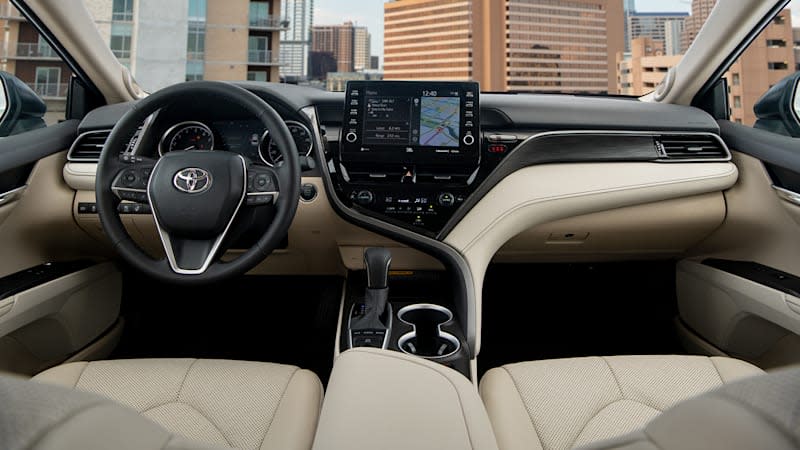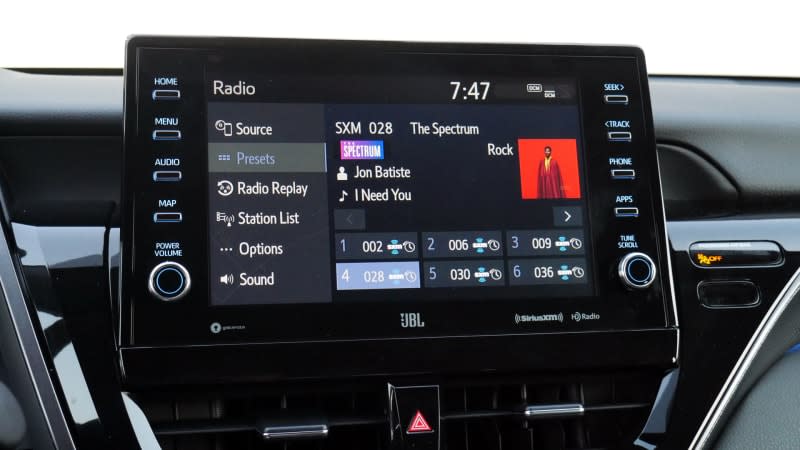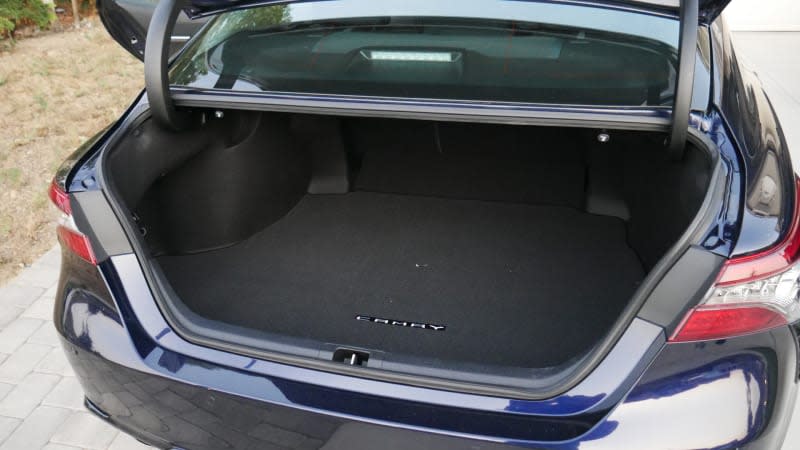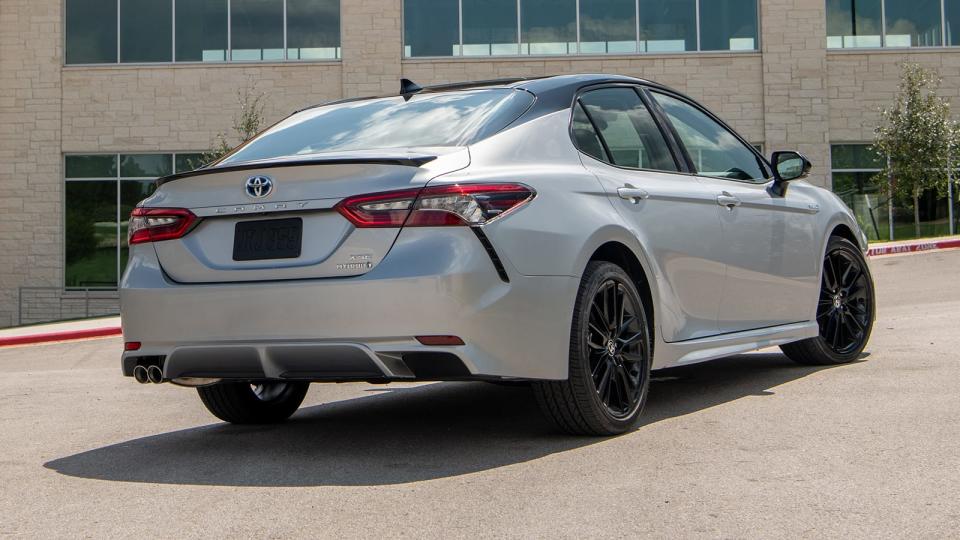2021 Toyota Camry Review | What's new, pictures, hybrid and AWD fuel economy

The 2021 Toyota Camry is not the drab beige appliance you might remember. This generation set a unique tone from the very beginning with its significantly enhanced driver involvement, interior quality and overall style. Toyota has steadily been updating it, too. Last year Toyota added an all-wheel drive option as well as a high-performance Camry TRD, which is also the most affordable way to get a Camry with a V6. This year brings updated infotainment and safety features, plus more trim selections for the Hybrid (Good news! It's out pick of the engine bunch!).
Despite being fundamentally different than the Camrys that came before, the 2021 should still satisfy the sensible buying criteria that's made it a best-seller for so long: strong reliability, good resale value and high safety ratings. So, while much has changed, much has also stayed the same. That's a good thing, and even if the Honda Accord is broadly more appealing, the Hyundai Sonata more distinctive and Mazda6 more fun to drive, the diverse, well-rounded Camry lineup is a must-consider.
What's new for 2021?
Changes for 2021 are minor. The Camry Hybrid is now available with the XSE trim, which combines the SE’s sportier appearance and suspension with some of the premium interior features from the XLE. All Camry models have very slightly tweaked front fascias that are a bit more aggressive. The latest version of Toyota’s Safety Sense driver-assist suite has been added, which includes adaptive cruise control with stop-and-go capability, lane-centering, automatic emergency braking with pedestrian detection, automatic high-beam headlights and a rear-seat reminder. The optional infotainment screen has grown in size from 8 inches to 9, necessitating a slight redesign of the dash. The barebones L trim level has been dropped, leaving the LE as the new base model.
What's the Camry interior and in-car technology like?
The Camry’s interior is mostly unchanged except for the infotainment screen, which now sticks out above the top of the dash. The dash is perhaps a little over-styled, but you can't call it boring, and we like that Toyota shies away from large swaths of tacked-on fake wood or metal to carry the look. Quality is also above average, as there really isn't much of drop-off in look, feel and general ambiance from a fancy XLE to the more entry-level LE. We also like the abundance of storage space in the doors, under the center armrest and in a voluminous two-tier smartphone bin.
The infotainment screen is no longer integrated into the center stack down low. It now sticks out of the top, above the air vents. The standard screen is 7 inches, and the optional one is 9 inches, the latter being an inch larger than last year’s optional screen. It’s not as clean looking as the previous version, but it does bring the screen closer to the driver’s line of vision, so it’s easier to check while driving. The touchscreen itself is also a love-it-or-hate-it affair. Some will appreciate its simple layout, especially for the audio controls. Others find it a bit slow and aesthetically behind the times (even though the screen is bigger it has the exact same user-interface and graphics as before). Either way, at least it now comes standard with all the latest, must-have smartphone connectivity features: Android Auto, Apple CarPlay and Amazon Alexa connectivity.


How big is the Camry?
If it weren't for the colossal Honda Accord, the Toyota Camry would stand out for its interior space. The lowered roof of the latest generation may make some folks feel like they're oddly close to the ceiling (especially with a sunroof), but headroom's still OK, and legroom is abundant. Someone 6-foot-3 can even sit behind another without knees grazing the seatback. We also like that the latest Camry has a lower driver seating position than before, making it feel like you're sitting in the car rather than on it. It's just one of the many things done to this generation to make it feel more immersive and driver-focused.
The trunk offers 15.1 cubic-feet of space, which is less than an Accord, a Sonata or VW Passat. In comparison to the Accord in particular, the trunk is a bit narrower and not as deep. However, that says more about those other sedans than the Camry. The trunk's still really big, with enough room for four roller bags and plenty left over. We can get a better feel for how much stuff the =trunk can hold in our Camry luggage test cargo review.
It should also be noted that the all-wheel-drive and hybrid Camry models have the same trunk space as the regular front-drive versions, but the hybrid’s back seat is a smidgen higher since the battery resides underneath. This difference is unlikely to be noticed, however.


What are the Camry fuel economy and performance specs?
The 2021 Camry is available with the widest variety of powertrain options in the midsize sedan segment.
Things start with the 2.5-liter inline-four that produces 203 horsepower (best in class) and 184 pound-feet of torque when paired with front-wheel drive (206 hp and 186 lb-ft in the XSE). The newly optional all-wheel-drive system (AWD) reduces output by a tiny amount. An eight-speed automatic is standard.
Fuel economy with this engine varies depending on trim level and drivetrain. The volume-selling LE and SE with front-wheel drive achieve an excellent 28 mpg city, 39 mpg highway and 32 mpg combined. The XLE and XSE take a minor hit at 31 mpg combined. All-wheel drive takes a further dive, especially on the highway, to 25 mpg city, 34 mpg highway and 29 mpg combined in the LE and SE (25/34/28 for the XLE and XSE AWD).
The optional 3.5-liter V6 is paired exclusively with front-wheel drive and the eight-speed automatic. It produces a whopping 301 horsepower and 267 pound-feet of torque. Unlike some turbocharged engines that require premium fuel to achieve max performance, the Camry's V6 runs on regular. Fuel economy is still strong at 22 mpg city, 33 mpg highway and 26 mpg combined for the XLE. The XSE gets 22/32/26, and the TRD trim brings up the rear at 22/31/25.
Finally, the Camry Hybrid uses a pair of electric motors in conjunction with a four-cylinder engine. Together, they produce a combined 208 hp. By comparison, a Prius produces a mere 121 hp, yet the Camry achieves nearly the same fuel economy. The Camry Hybrid LE trim level returns 51 mpg city, 53 mpg highway and 52 mpg combined. The other trims are 44/47/46, a difference that isn't as significant as the numbers make it seem.

What's the Camry like to drive?
Forget all your pre-conceived notions of the Toyota Camry. It is a far more involving car than ever before with sharper, more composed handling and pleasantly responsive steering. Everything gets a bit tighter in the SE and XSE trims, but choosing them isn't an absolute must any more for folks who like to drive. True, the Honda Accord and Mazda6 remain superior drivers' cars, but the Camry isn't so far off.
In fact, the Camry TRD was seemingly made to make that very point, as it's outfitted with track-tuned chassis components, a strengthened structure and enhanced steering to deliver handling that approaches sport sedan territory, at the expense of a less-forgiving ride.

 Yahoo Autos
Yahoo Autos 

